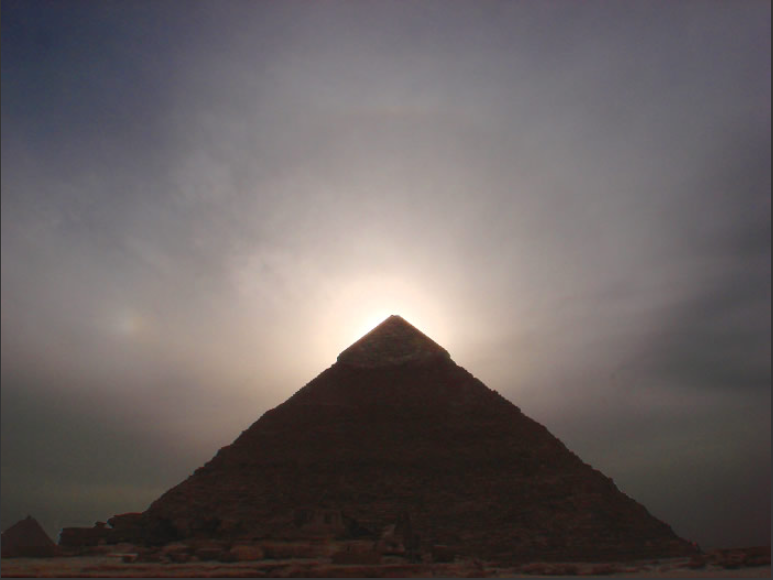Sundog & Ra
Sundog & Ra: Ancient Egyptian Mythology Meets Atmospheric Optics
The ancient Egyptians worshipped the sun god Ra, who was believed to traverse the sky in various forms throughout the day. Ra-Herakhty represented the rising sun, Ra-Atum symbolized the setting sun, and Aten was associated with the solar disk. However, curiously absent from their mythology are any references to sundogs or parhelia, which would have likely accompanied Ra on his daily journey across the sky.
Sundogs, also known as mock suns or parhelia, are fascinating atmospheric optical phenomena that occur when sunlight is refracted by ice crystals in the atmosphere. These crystals act as prisms, bending the light and creating a colorful display around the sun. The result is two bright spots on either side of the sun, appearing like miniature suns.
The most common type of sundog is known as a 22-degree halo. This halo forms when sunlight passes through hexagonal ice crystals with their long axes oriented horizontally. The light is refracted twice as it enters and exits the crystal, resulting in a halo that is 22 degrees away from the sun. This halo often accompanies sundogs and can be seen as a complete circle around the sun under the right atmospheric conditions.
In addition to sundogs and the 22-degree halo, another optical phenomenon called the upper tangent arc may also be visible. This arc appears as a subtle curve above the sun and is caused by sunlight passing through hexagonal ice crystals with their long axes oriented vertically. The light is refracted as it enters and exits the crystals, creating this faint arc that adds to the ethereal beauty of the display.
While sundogs and other atmospheric optics phenomena were not explicitly recognized in ancient Egyptian mythology, it is possible that they were observed and appreciated by the ancient Egyptians. Given their advanced knowledge of astronomy and their deep reverence for the sun, it seems likely that they would have noticed and pondered the existence of these celestial wonders.
The absence of direct references to sundogs and parhelia in ancient Egyptian texts could be attributed to various factors. It is possible that these phenomena were considered too mundane or ordinary to be included in the mythology surrounding the powerful and awe-inspiring sun god Ra. Alternatively, it could be that the ancient Egyptians simply did not have the vocabulary or conceptual framework to describe these optical phenomena in their mythological narratives.
Regardless of the reasons behind their omission from ancient Egyptian mythology, sundogs and related atmospheric optics phenomena continue to captivate and intrigue us to this day. Scientists and photographers alike marvel at the stunning displays of light and color that can be observed under the right atmospheric conditions. From ancient times to the present day, the allure of these natural wonders continues to inspire us to explore and understand the mysteries of our atmosphere.
In conclusion, while ancient Egyptian mythology may not explicitly acknowledge the existence of sundogs and parhelia, it is plausible that these atmospheric optical phenomena were observed and appreciated by the ancient Egyptians. The intricate displays of light and color created by ice crystals in the atmosphere continue to mesmerize us, reminding us of the profound beauty and complexity of our natural world. Whether viewed through the lens of ancient mythology or modern science, sundogs and related phenomena serve as a testament to the enduring fascination humans have with the wonders of the sky.

Image by Aymen Ibrahem (Night Sky over Egypt) of the Bibliotheca Alexandrina, Egypt. ©Aymen Ibrahem, shown with permission.
The 4500 year old bulk of the pyramid of Pharaoh Khafra (Chephren) shields the sun to reveal a sun dog, a 22 degree halo and a hinted upper tangent arc.
Ancient Egyptians recognised several manifestations of the sun god Ra, Ra-Herakhty of the rising sun, Ra-Atum of the setting sun and Aten the solar disk. Strangely, there is no acknowledgement of the sundogs or parhelia that must at times have accompanied Ra on his daily journey across the sky.
Note: this article has been automatically converted from the old site and may not appear as intended. You can find the original article here.
Reference Atmospheric Optics
If you use any of the definitions, information, or data presented on Atmospheric Optics, please copy the link or reference below to properly credit us as the reference source. Thank you!
-
<a href="https://atoptics.co.uk/blog/sundog-ra/">Sundog & Ra</a>
-
"Sundog & Ra". Atmospheric Optics. Accessed on November 26, 2024. https://atoptics.co.uk/blog/sundog-ra/.
-
"Sundog & Ra". Atmospheric Optics, https://atoptics.co.uk/blog/sundog-ra/. Accessed 26 November, 2024
-
Sundog & Ra. Atmospheric Optics. Retrieved from https://atoptics.co.uk/blog/sundog-ra/.